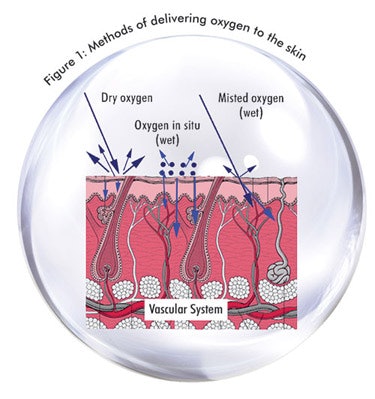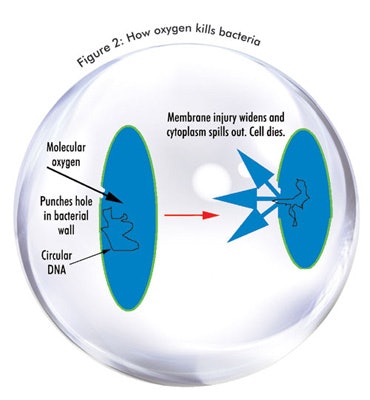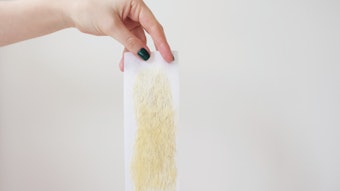
This article is written to provide the esthetician with a working knowledge of oxygen as a therapeutic modality. It is important to understand that oxygen is not a miracle remedy; it is, however, a very effective agent to treat many skin conditions that the esthetician sees almost daily. Although this article won’t go into great detail about the science of oxygen or free radical theory, it will touch on these topics lightly, as well as what skin conditions respond best to oxygen and why. The conditions to be covered include oxygen use in the treatment of acne, rosacea and aging skin.
Oxygen in the atmosphere
About two billion years ago, oxygen first appeared in the atmosphere as a by-product of single-cell metabolism. These creatures ran out of the initial food stuff in the oceans and had to synthesize their own food. Three raw materials were available to them: water, air (carbon dioxide) and sunlight, and from these, they synthesized sugars, or carbohydrate compounds. Water was split into hydrogen and molecular oxygen; carbon dioxide was split into carbon and oxygen; and the sun, in the form of photons, supplied the energy necessary to do all this work. Although the details are a fascinating read, this is not the place to go into depth with them. One important fact that you need to know is that this process produced a lot of molecular oxygen in the form of O2. Now keep in mind that all the organisms on Earth this time lived with oxygen (anaerobic), so oxygen became toxic to them and many hundreds of thousands of species died because of the toxicity of atmospheric molecular oxygen.
Some species obviously adapted to the presence of oxygen and survived, otherwise people would not be on the planet today. These species had mitochondria, which enabled them to make maximum use of oxygen as an energy source along with the sugars. The take-home lesson here is that oxygen is essential for life, and it became involved in the development of humans during the course of many millions of years in many ways. Even today, not every biological function of oxygen is known.
Oxygen and energy
With the advent of oxygen in the atmosphere, cells that were able to adapt to the presence of oxygen made great use of it as part of their energy systems. All energy on Earth is derived from the sun, in one form or the other, but humans’ biological energy comes indirectly from plants. Plants synthesize sugars via photosynthesis, people then eat the plants and break down the sugars to release biological energy in the form of adenosine triphosphate (ATP). Don’t worry about all the steps involved, just remember that oxygen is essential for that process to occur.
A large amount of the oxygen used by the skin passes into the skin from the atmosphere. A critical point to remember is that oxygen must diffuse into the skin and then down to the basal layer of the epidermis. Although a certain amount is used by the upper layers of the epidermis, the basal layer consumes most of the epidermal oxygen. Why is this important? Without the ability to get the oxygen into the skin first and then down to the basal layer next, it would not make any sense for oxygen to be used as a therapeutic modality. Diffusion laws are complex and the physics are a bit stiff, but you really do not need to know all of that to be able to use oxygen effectively. There are three conditions that respond to oxygen therapy: acne, rosacea and aging skin. For each of these biological disorders, the underlying pathology must be examined in order to appreciate and understand the role of oxygen in the treatment process.
Acne vulgaris
The pathogenesis of acne vulgaris is characterized by four factors. Follicular epidermal hyperproliferation is the first and is associated with subsequent follicular plugging. Next is the overproduction of sebum, with the third factor being the anaerobic bacteria Propionibacterium acnes (P. acnes), which is associated with the fourth factor, inflammation. The esthetician needs to appreciate these and know how to contend with each.
Epidermal hyperproliferation. Starting with the formation of adrenal androgen before puberty, the sebaceous follicle is triggered to proliferate and is followed by the plugging of the follicle. It is believed that the adrenal hormone dehydroepiandrosterone (DHEA) is the cause of this early manifestation of acne because the appearance of comedones is first noticed during this time. It requires the presence of androgen receptors in the follicle to form a comedone, since those individuals who lack these androgen receptors or who have poorly functioning androgen receptors do not get acne.
Sebum overproduction. The second factor, the overproduction of sebum, is also related to the action of androgens. For some reason, linoleic acid is low in the follicles of people with acne, while in those mostly acne-free, it is normal. As a result of excess sebum, acneic skin tends to be oily and appear shiny.
P. acnes and inflammation. The third factor, the presence of P. acnes, is also related to the fourth factor, inflammation. Oddly, P. acnes is rarely seen in early acne lesions—the microcomedo—and is generally not found until later. Keep in mind that this organism is anaerobic and resides deep in the follicle, away from atmospheric oxygen, which it does not like. It is the P. acnes that is responsible for the inflammation seen in acne, the papule and the pustule, as well as the cyst in cystic acne. As with many bacteria, P. acnes produces mediators of inflammation that start the cascade of inflammation propagated by white blood cells, the leukocytes.
Here is a new term for you to remember: the toll-like receptor. This is a primitive defense receptor on monocytes and neutrophiles (two kinds of white cells), which, when activated, leads the cell to produce cytokines, such as Interleuken 12 (IL-12), IL-8 and tumor necrosis factor (TNF). In addition, IL-1a is also present and may be a contributing factor. Now, if you are not familiar with cytokines, you might say, “So what?”
Briefly, cytokines are special signaling proteins and proteins linked with sugars called glycoproteins. They are very much like hormones that are able to provide signals to other cells by cellular communication. Cytokines are a diverse class of compounds arising from many origins and having multiple functions. Both blood cells and nonblood cells can produce them, and their effects can be felt by cells nearby and throughout the body. Mainly, they are a response to trouble, but they often produce more trouble. The body could not exist without them.
In summary, inflammation in acne is mainly the result of P. acnes and the cytokines they evoke from white blood cells. Along with the other factors, the acne follicle is a roaring source of inflammation.
Oxygen in acne treatment
Every effective therapy treats the causes of the disease. When looking at the causes of acute acne, the presence of P. acnes stands out as a major factor in the formation of pimples or cysts. It is important for the esthetician to understand just what is happening when oxygen is being delivered to the skin. See Figure 1.
Diffusion of atmospheric oxygen. The excellent work of Strucker, et al1 shows that the needs of the epidermis can be supplied with oxygen from the atmosphere through a diffusion process. The epidermis, however, needs additional oxygen, which is supplied by the capillaries. The skin uses oxygen to kill bacteria, to supply energy to the cells, to reduce swelling, to stimulate fibroblast activity, to inhibit lipid peroxidation and to initiate new blood vessel production. It is unknown how these actions occur, but it has been identified through experience with medical hyperbaric oxygen that they do occur.a By using wet oxygen—either mist-laden or in a solution—you are able to get effective levels of oxygen into the hair follicle, deep enough to reach the sebaceous gland. This is the No. 1 reason for using topical oxygen for acne.
Bacterial kill mechanism. It is most likely that a free radical reaction occurs at the cell surface of the bacteria. Oxygen can form very reactive by-products, such as hydrogen peroxide and superoxide, when they enter a cell. The targets of the reactive oxygen species (ROS) are protein and DNA, which denatures both these compounds. It is not fully known what the antimicrobial mechanisms of oxygen are, but some of these processes are understood. For example, the cell envelopes of bacteria consist of polysaccharides (complex sugars) and proteins. Some bacteria have a lot of complex lipids in their membranes, including glycolipids and lipopolysaccharides.
Oxygen reacts with the lipid layer in cellular membranes, usually forming hydroperoxides and a lot of other nasty-but-active germ-killing compounds. Net result: Oxygen breaks the bacterial cell envelope by lipid peroxidation. So basically, oxygen has effectively punched holes in the cell’s membrane, causing the bacteria’s nucleic acids and other critical compounds to exit the cell, thereby killing the bacteria. Besides this method, oxygen kills bacterial pathogens disrupting the system that creates the cell’s energy, as well as crippling the critical proteins’ manufacturing systems. See Figure 2.
Treating acne with oxygen. The current acne treatment regimen used should continue and the oxygen treatment should be adjusted according to the acne’s severity. In severe noncystic acne, use oxygen therapy three times a week for the first week.b During the second week, reduce to two treatments administered at least 2–4 days apart. On the third week and subsequent weeks, oxygen used once a week should produce good and lasting results. Have the client return in a month to check for comedones, both open and closed. As you are well aware, acne is a recurrent disease and those experiencing it should be followed up with regularly, often beyond the teen years. Acne and ignorance are the scourges of youth.
There are only two methods of oxygen application that I recommend and both use wet oxygen. The nebulizer format allows estheticians to use additional agents during the application, such as essential oils or plant extracts. The other form is oxygen generated in situ—that is, on the skin—and can be effectively used in a treatment lasting less than 10 minutes. Both of these systems are commercially available. Whatever system you use, make sure you understand it, and follow the directions of the supplier.
Rosacea
Of all the many diseases of obscure etiology, rosacea should rank near the top of the list. It is known that a lot of people have rosacea—an estimated 13–14 million in the United States.2 It occurs most frequently in people ranging from 30–50 years of age and is found primarily in fair-skinned people with northern European ancestry. Women, for some reason, are affected about two to three times more often than men.3 Rosacea is characterized by a persistent erythema of the face for a duration of at least three months. Diagnostic signs include flushing, papules, pustules, telangiectasias, edema, plaques, a dry appearance, ocular manifestations and phymatous changes. Symptoms include burning and stinging. A major finding is central facial flushing, often accompanied by burning or stinging. Patients generally have finely textured skin, although the face may appear rough and scaly, suggesting a low-grade dermatitis. Known triggers to flushing include emotional stress, alcohol, spicy foods, exercise, cold or hot weather, hot drinks, and hot baths and showers. Rosacea patients frequently have sensitive skin and may feel pain with many products, even when they are gently applied to the skin.
A present controversy is the concurrent existence of acne and rosacea. As a rule, no comedones are seen in rosacea. My personal opinion is that acne is a separate disease from rosacea. I base this on the fact that rosacea is characterized histopathologically with the appearance of perivascular infiltration. This would suggest some basic vascular pathology, which is to say, it covers a lot of area, but it presents a clue or starting point. Why do only men get rhinophyma with rosacea? Studies have shown possible associations between rosacea and the face mite Demodex folliculorum 4, 5 and Helicobacter pylori infection.6, 7, 8
Treating rosacea with oxygen. Treatment by the medical profession for rosacea is essentially an attack with antimicrobial agents, but for more resistant cases, physicians use surgery, dermabrasion, laser and more recently, intense pulsed light (IPL). The esthetician has limited use of these modalities, but there are still effective treatment methods available. Since there appears to be a bacterial component to rosacea, an antimicrobial product should be used along with an anti-inflammatory. You have your choice of many anti-inflammatory agents, both natural and synthetic. Bioflavanoids and other polyphenols from green tea are effective. Consider also bisabolol from the plant chamomile. One very powerful antioxidant found in pomegranate is ellagic acid, with a great many other positive properties, such as an antiperoxidant, antiseptic, antibacterial, astringent, antifungal, antiyeast, and it is a sunscreen, as well, when added at 0.5%.
Topical oxygen should be applied in a wet form, carefully following the directions of the manufacturer. When you see the skin blanch, you know you have reached the top of the dermis with your oxygen treatment. At the same time, you will have killed many of the superficial and deep-surface bacteria, and probably killed the demodex, or else made them very unhappy.
The treatment program for rosacea should follow an initial three treatments the first week, two the second week and one the third week. Depending on the improvement, scheduling of the subsequent treatments can vary from biweekly to monthly. As the reader is well aware, rosacea clients do not all respond the same, so adjust your treatment to meet the needs of a particular client.
Aging skin
Aging remains a major topic in science because, even today, the process isn’t fully understood. It is known, for example, that tissues and cells undergo damage, that a person’s DNA may also be damaged, and that a lot of systems do not work as well at age 50 as they do at age 20. There are many questions, but few answers, although a great deal has been learned during the past few years about some important aspects of aging that can be translated into skin care. Energy and living are forever linked, and so is the aging process. Having adequate energy for every organ is essential for the normal function of each organ, and that means each cell must have a good supply of energy. The skin is one organ that almost always comes off on the short end of the metabolic stick.
Waste products accumulate in the skin, its blood and nutrients are shunted to other organs in emergency situations, and nasty metabolic by-products are frequently sent to the skin to be neutralized. The sun and cold are not the skin’s friends, nor are harsh detergents and soaps. Next to the stomach, the skin is the most abused organ in the body. The skin can be helped, however, if enough energy is supplied to it, and that is one thing oxygen therapy can do.
The mitochondria. Tremendous strides in the information known about mitochondria have been made during the past 30 years. They are the major energy source for the cell and are damaged rather easily because they do not have adequate repair mechanisms. In a previous article, mitochondria were discussed, as well as how they produce ATP. Every movement or thought, and most chemical reactions that occur in the body, require ATP. In fact, so much ATP is used by the body that each day, it makes and uses about 80 pounds of it. Staggering! Oxygen is critical to the process of generating ATP.
Aging skin features a decrease in circulation, metabolic activity, ATP production and a sluggish immune system. The skin is also insulted daily with free radicals, both inside and outside the body. Any treatment of aging skin should begin with an adequate antioxidant regimen. A good, glycation-free diet with a modest caloric intake can prevent many unnecessary hospital days.
Treating aging skin with oxygen. Oxygen can be used as an adjunct treatment in your skin care anti-aging program. Remember to always use wet oxygen.
Include in your aging skin treatment program three oxygen treatments during the first week, and a series of three treatments the next week. During this time, you could use one enzyme peel each week for the first two weeks. During the third week, look for changes in texture, color and fine lines. The third week, give two more oxygen treatments—although the timing is not critical, they should be two to three days apart, but do not administer them back to back. After the third week, you can adjust your treatments to once a week or alternate weeks for six to eight weeks, depending on the condition of the client’s skin.
Look at two parameters in order to evaluate wrinkles.
How deep are they? Even one or two deep wrinkles suggests a great deal of damage to the dermis. Little wrinkles will hold a thread; moderate wrinkles will hold a string; severe wrinkles are deeper and wider than the wire in a coat hanger.
How long are they? Except for the nasolabial fold and the labiomental fold, wrinkles that measure longer than an inch are really bad. These wrinkles reveal that there is a great deal of dermal damage and will most likely fail to respond to anything other than deep surgical peels.
Oxygen and the skin
Oxygen revitalizes the epidermis and stimulates cellular growth by increasing cellular proliferation. It will kill surface bacteria, deep anaerobic bacteria and fungus. Oxygen will supply energy to the epidermis and to the dermis, helping to heal any small wounds and irritations. In the dermis, it will help produce collagen and elastin and help restructure the extracellular matrix. Oxygen is a micronutrient and it will assist with many metabolic processes in the skin. Lastly, it is critical for many enzyme reactions, and the presence of oxygen can often accelerate these reactions.
How often can you use oxygen therapy? The cost of the treatment must be considered, but the client is the most important factor. Remember that using oxygen is an art. You must know how to use it. If a company tries to sell you an oxygen treatment without adequate education or instruction, steer clear of it. You will begin to see oxygen used more often in esthetics within the next few years, and perhaps in combination with other treatment systems.
FOOTNOTES
a. Hyperbaric oxygen is usually administered in a sealed, heavy-walled chamber. By definition, hyperbaric oxygen is above one atmosphere of oxygen pressire, normally about 160 mm mercury.
b. Cystic acne should always be treated by a physician.
REFERENCES
1. M Strucker et al, The cutaneous uptake of atmospheric oxygen contributes significantly to the oxygen supply of human dermis and epidermis. J Physiol (538) 985–994 (2002).
2. T Cuevas, Identifying and treating rosacea. Nurse Pract (26) 13–15, 19–23 (2001)
3. M Berg, S Liden, An epidemiological study of rosacea. Acta Derm Venereol (69) 419–423 (1989)
4. T Roihu, AL Kariniemi, Demodex mites in acne rosacea. J Cutan Pathol (25) 550–552 (1998)
5. Z Erbagci, O Ozgoztasi, The significance of Demodex folliculorum density in rosacea. Int J Dermatol (37) 421–425 (1998)
6. B Wedi, A Kapp, Helicobacter pylori infection and skin diseases. J Physiol Pharmacol (50) 753–776 (1999)
7. JT Bamford, RL Tilden, JL Blankush, DE Gangeness, Effect of treatment of Helicobacter pylori infection on rosacea. Arch Dermatol (135) 659–663 (1999)
8. VK Sharma, A Lynn, M Kaminski, R Vasudeva, CW Howden, A study of the prevalence of Helicobacter pylori infection and other markers of upper gastrointestinal tract disease in patients with rosacea. Am J Gastroenterol (93) 220–222 (1998)












